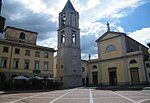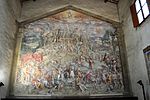Villa La Magia
Medici villasQuarrataUse British English from June 2017Use list-defined references from June 2017

Villa La Magia is a Medici villa in the comune of Quarrata, in the province of Pistoia, to the west of Florence, in Tuscany in central Italy. It was built by the Panciatichi family in the fourteenth century, and was bought by Francesco I de' Medici in 1583 or 1584. It has been owned by the comune of Quarrata since 2000, and since 2013 has been one of the fourteen sites which together make up a UNESCO World Heritage Site, the Medici Villas and Gardens in Tuscany.
Excerpt from the Wikipedia article Villa La Magia (License: CC BY-SA 3.0, Authors, Images).Villa La Magia
Via Magia,
Geographical coordinates (GPS) Address External links Nearby Places Show on map
Geographical coordinates (GPS)
| Latitude | Longitude |
|---|---|
| N 43.8516 ° | E 10.9726 ° |
Address
Villa La Màgia
Via Magia
51039
Tuscany, Italy
Open on Google Maps










